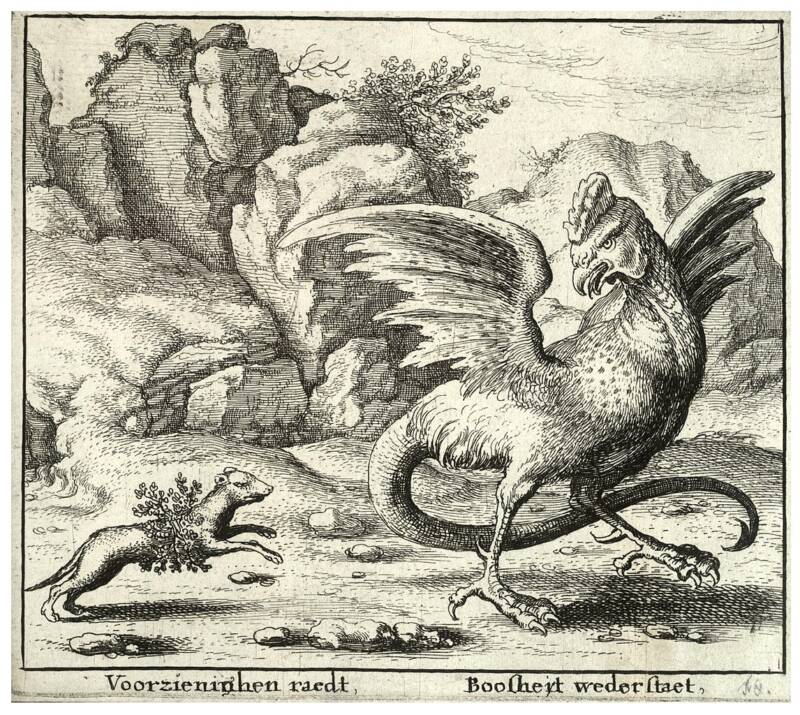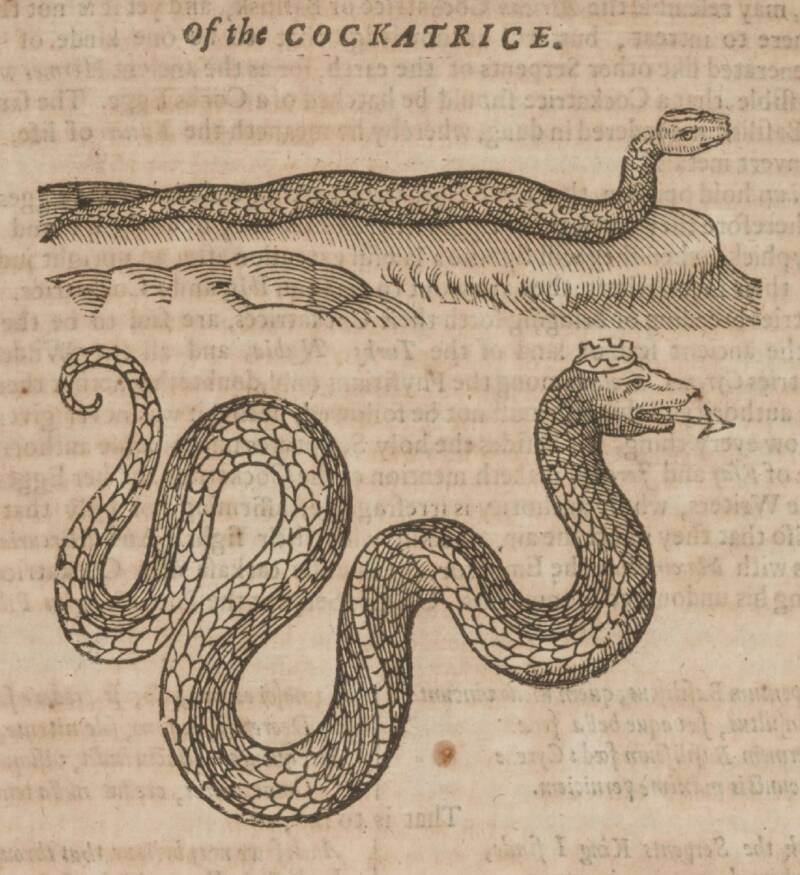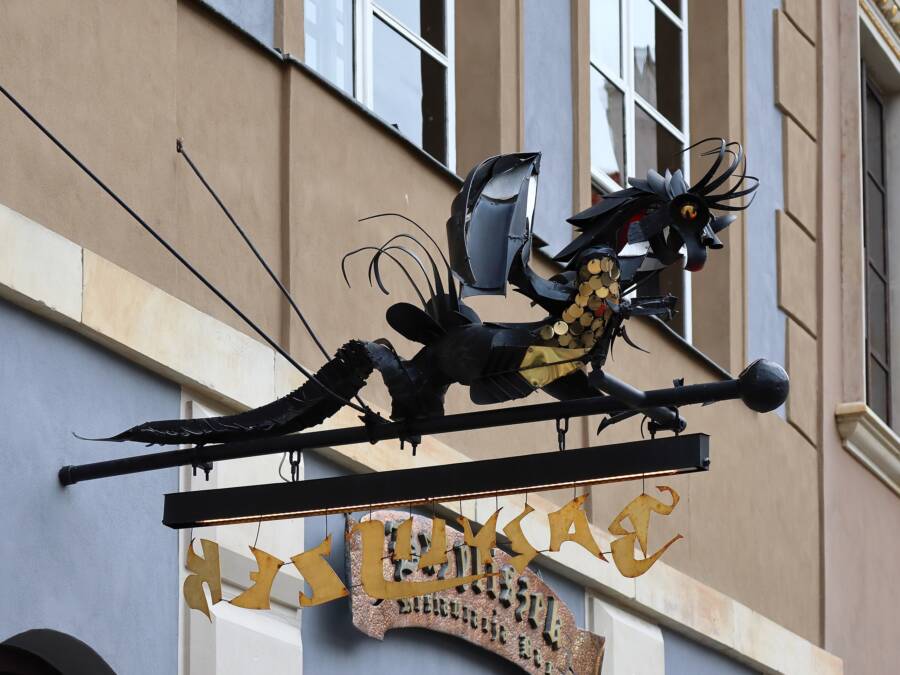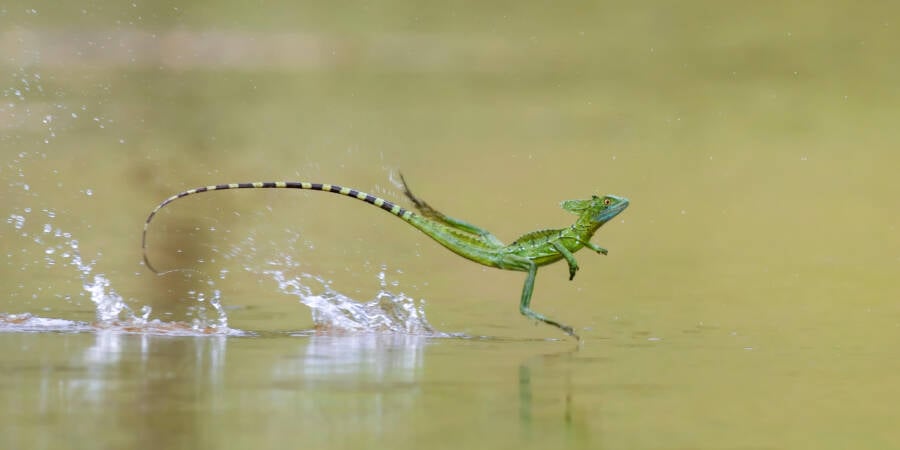Many are familiar with the snakelike basilisk from the Harry Potter series, but the ancient legend of this serpent king describes a monster much different from the one that the young wizard encountered in the Chamber of Secrets.
Called the “king of serpents,” the basilisk has slithered through terrifying legend for thousands of years, from Roman times to its modern depiction in Harry Potter and the Chamber of Secrets. This mythological monster is said to possess deadly powers, most famously its ability to kill victims with a single, lethal glance.

Public DomainA basilisk, right, fighting off a weasel, which is the only animal immune to its venom.
But the basilisk of legend is different from how it appears in popular culture today. Not only is the “serpent king” said to be a rather small creature — just “twelve fingers” long, according to writers in antiquity — but it’s also often equated with the cockatrice, a rooster-snake monster hybrid.
This is the legend of the basilisk, from the first descriptions of it 2,000 years ago to its appearance in various myths throughout history.
The Origins Of ‘This Dreadful Monster’
Though the basilisk is an ancient creature — it’s afforded passing reference in the Bible, including in the Book of Isaiah — Pliny the Elder was the first to describe it in detail. In 79 C.E., the Roman writer published his Natural History, an encyclopedic work that covers a number of different subjects.
Pliny described the basilisk as a small, serpent-like creature “not more than twelve fingers in length.” He claimed that it comes from Libya and that, despite its diminutive size, it possesses deadly powers. The basilisk is famous for its deadly stare, but Pliny claimed its abilities go far beyond that.
“When it hisses, all the other serpents fly from it,” Pliny wrote. “It destroys all shrubs, not only by its contact, but those even that it has breathed upon; it burns up all the grass, too, and breaks the stones, so tremendous is its noxious influence. It was formerly a general belief that if a man on horseback killed one of these animals with a spear, the poison would run up the weapon and kill, not only the rider, but the horse, as well.”

Public DomainA 17th-century depiction of the basilisk, which also came to be equated with the cockatrice. Pliny the Elder described the monster as a serpent, though others claimed it was more of a rooster-serpent hybrid.
Indeed, the Romans reportedly believed that an infestation of basilisks turned the Sahara from fertile land to desert.
Though it may seem that the basilisk’s powers make it invincible, Pliny claimed that there was one creature that could kill the serpent: a weasel.
“To this dreadful monster the effluvium of the weasel is fatal,” Pliny wrote. “The animal is thrown into the hole of the basilisk, which is easily known from the soil around it being infected. The weasel destroys the basilisk by its odor, but dies itself in this struggle of nature against its own self.”
And as time went on, the legend of the basilisk grew.
The Basilisk In The Middle Ages
After the fall of the Roman Empire, the legend of the “king of serpents” evolved. The basilisk began to be equated with the cockatrice — a half-rooster, half-snake — and it was imbued with new powers.

Public DomainAfter the Roman era, the basilisk was increasingly described as a rooster-serpent hybrid, said to come from a rooster’s egg that was hatched by a toad or snake.
During the Middle Ages, the basilisk was accused of starting a plague in Rome and triggering a fainting sickness in Vienna. Both incidents were blamed on the basilisk’s noxious odor, which contained powers of its own. In the first case, the basilisk was purportedly found hiding under an arch and was killed by the pope; in the second, hunters found it dead in a well.
Vigilant locals across Europe also kept an eye out for roosters that laid eggs, since the cockatrice was reputed to come from an egg laid by a rooster and hatched by a toad. On a handful of documented occasions, enraged and terrified mobs killed roosters found to be laying eggs, sometimes in public executions. (Smithsonian Magazine reports that these “roosters” may have been hens with unbalanced hormones that gave them male attributes.)
One of the best-documented stories of the basilisk, however, comes from when the monster purportedly terrorized Warsaw, Poland.
Defeating The Monster In Warsaw
The legend of the Warsaw Basilisk differs depending on the retelling. Some, including an account reported by Atlas Obscura, describe a town terrorized by the monster “a long time ago.” The basilisk in this tale lived in a ruined castle during the day and came out at night to steal livestock, destroy buildings, and kill its victims by turning them into stone.
When a tailor named Jan Ślązak came to town and was wrongly accused of murder, one of the townspeople who’d lost a child to the basilisk suggested Ślązak could escape his death sentence if he killed the beast. Ślązak brought a large mirror into the ruined castle and roused the basilisk from sleep. When the monster saw itself in the mirror, it turned to stone.
Other versions of the legend are slightly different. Smithsonian Magazine describes a similar but slightly less dramatic scene that took place in the 16th century. In this version, two young girls are found dead in a dilapidated house. Upon recovering their bodies, the locals realize that they’d been killed by a basilisk.

Cybularny/Wikimedia CommonsA statue of a basilisk outside a restaurant in Warsaw, Poland, purportedly at the site of its former lair.
They also send a convict to kill the monster — in this version, his name is Johann Faurer — who covers himself in a suit of mirrors and succeeds in dragging the basilisk into the sunlight, where its powers are diminished. Here, it’s described as having “the head of a cock, the eyes of a toad, a crest like a crown, a warty and scaly skin… and a curved tail, bent over behind its body.”
Of course, the basilisk also made an appearance in the second book of the Harry Potter series, where it’s described as a giant snake with a lethal gaze (in the book, looking at the snake’s reflection results in petrification, a spin on the “mirror” legend as described in Warsaw).
Fortunately, the basilisk lives only in legend — or does it?
The ‘Real Life’ Basilisks Of The World
Actually, there are “real life” basilisks, but they can’t turn people to stone or transform fertile land into deserts. The common basilisk (Basiliscus basiliscus) is just a lizard that lives in Central and South America.
But though it may not be able to terrorize villages, the common basilisk does have some powers. When fleeing predators, it’s able to run across the water (which is why it’s been nicknamed the “Jesus Christ lizard.”)

Nature Picture Library / Alamy Stock PhotoA basilisk in Costa Rica running across the water.
Fortunately, the common basilisk is more interested in eating insects and other small creatures than feasting on human beings.
As such, the basilisk, the terrifying monster able to kill with a glance or poison the air, seems to be resigned to legend. But you never know. If you smell a foul odor in an abandoned place, you’d better have a mirror handy.
After reading about the legend of the basilisk, discover the stories of other mythological creatures. Or, learn about some of the scariest monsters from Native American folklore.






